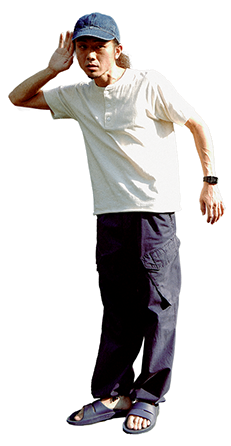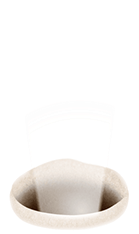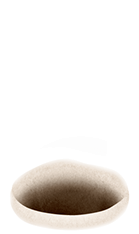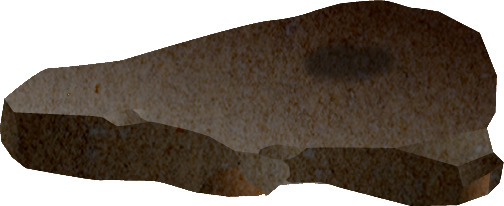
YUYA SHIRATORI
TAP ME
Well, what do you want me to talk about?
さて、何についてお話ししましょう。
— なぜ、角なの?
why the horn?
— それで、なんでツノをモチーフに?
So, why the horn motif?
— 真刻の角獣って?
What is a - Horns from the Core- ?
— 何でおどるの?
Why do you dance?
— 何を表現し、何を伝えたい?
What do you want to express, and what do you want to communicate?
やめとく
quit asking
−なぜ、角なの?
私が創る角たちは、全て牛科の角をモチーフにしています。
牛科ってなに?っていうと、牛やひつじ、やぎ、バイソン、ガゼル、数え出したらキリがない。鹿のもつ枝のような角、それ以外は大抵牛科です。鹿科の枝角が毎年生え変わるのに比べ、牛科の洞角(ほらづの)は生涯成長し続けます。鹿科がオスのみに角があるのに比べ、牛科はオスメス両方に角があるのも、大きな違いです。(例外種もあり)
なんといっても牛科の角は、頭蓋骨直結、中に血が流れている!というのも惹かれる要素ですね。
そこに、強い意志みたいなものを感じるんです。
— why the horn?
The horns I create are all based on the motif of horns of the bovine(cow) family.
What is a bovine family? Cows, sheep, goats, bison, gazelles, the list goes on and on. Deer have antlers that look like branches, and most of the rest are in the bovine family. While the antlers of the deer family grow back every year, the horns(cavicorn) of the cattle family continue to grow throughout life. Another big difference is that both males and females have horns, while only males have antlers in the deer family. (There are exceptions to this rule.)
The horns of the bovine family are directly connected to the skull, and there is blood inside! This is another factor that attracts me.
I feel something, like a strong WILL in them.
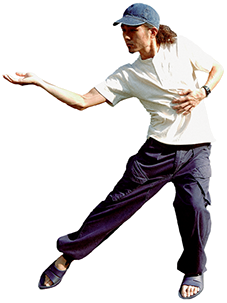
−それで、なんでツノをモチーフに?
角を持つ動物たちって、なんだか日本人ぽいなぁって思うんです。
彼らが角を使う時って、普段の生活ではごく稀なんです。オス同士の縄張り争いや、メスの奪い合い、肉食獣に襲われた時、そして、仲間を守るとき。あんなに美しいフォルムの造形を、結構重いのに、あまり使わないんですw
日本人って、他国に比べて、少し内向的な印象を受けるんです。はっきりしてないというか。美しいものを持っているのに、自信を持って個性を逸脱させるのが苦手というか。集団になりがちというか。牛科の動物たちも、大抵は群れで暮らしてる。
ネガティブな意味ではなくて。そういった、気高い角、生きていく上での信念みたいなものを誰しもが持っていて。だけど、それは毎日頻繁に使うものじゃない。そこに、日本人、人間っぽさが重なる気がするんです。
— So, why the horn motif?
I think that animals with horns are something similar to Japanese people.
They use their horns very rarely in their daily lives. They use their horns in territorial disputes between males, when they are fighting for females, when they are attacked by predators, and when they are protecting their family. Even though they are quite heavy, they don't get much use out of such beautiful forms.
I get the impression that Japanese people are a little more introverted than other countries. We don't seem to be very clear. We have beautiful things, but we are not good at deviating from their individuality with confidence. We tend to be grouped together. Most of the animals in the bovine family also live in groups.
I don't mean that in a negative way. Everyone has such a noble horn, a kind of belief to live by. However, it's not something that we use often every day. I feel that there is an overlap of Japanese people and also humanity there.
−真刻の角獣って?
昔から、ツノに対する憧れみたいなものがありました。かっこいいし、美しいし、わけがわかんない。なんであんなものが頭から生えているんだ?!なんのために??って。気付いたら角の絵を描いたり、作ったり、被ったりしてましたね。角のある獣。角獣は、なぜだか僕の中にずっといるんです。
真刻って言葉は、造語なんです。一緒に企画製作しているYuuと展示タイトルを考えていて、ようやく捻り出したワード。
心の奥底にあるトラウマだったり、苦しみ、悲しみ、感動、歓喜の瞬間だったり。そこから生まれる自己形成の強い思念。そういったものを、角獣たちのツノにのせて、表現したいなって。人の芯深く、いちばん真ん中にあるところ。そこにズシャッと刻まれているもの。
最初は深谷の角獣だったんだけどね。精神の深いところ、谷にいる角獣。でもそしたら、全国のふかやさんが反応しちゃうから、やめたw
— What is a - Horns from the Core- ?
Japanese title “Shinkoku no Kakuju” ?
I've always had a kind of fascination with Horns. They're cool, they're beautiful, and I don't get it. Why do they have those things growing out of their heads? What are they for? ,,, I found myself drawing pictures of horns, making them, and wearing them. “A beast with horns”. I don't know why horned beasts have always been a part of me.
The word “Shinkoku” is a coined word. Created with two Chinese characters “Shin” and “Koku”. Shin means real and true. Koku means curving and engraving. It's a word that I finally came up with when I was thinking about the title of the exhibition with Yuu, who is working on the project with me.
It can be a trauma deep inside, a moment of pain, sorrow, emotion, or joy. The strong thoughts of self-formation that arise from them. I wanted to express these things by putting them on the horns of the horned beasts. Deep in the core of a person, in the very center. That's where they are engraved.

−何でおどるの?
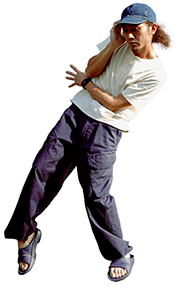
生の身体で表現するのって、嘘がつけないんです。彫刻や絵画などの作品は、時間をかければ、いくらでもブラッシュアップしていける。
想いをまっすぐに作品にこめるって、すごい難しいと思うんです。やっぱり、「かっこよく」見えるように、仕上げてしまう。
でも、おどってる時って、その瞬間にしか存在しないんです。その場所、匂い、気温、身体の調子、メンタル、全部がその瞬間に存在していて、次の瞬間もう違うものになっている。
その刹那性に惹かれます。
— Why do you dance?
I can't lie when I express myself with my real body. Sculptures and paintings can be brushed up as much as you want if you spend enough time on them.
I think it's very difficult to put your thoughts straight into your work. You end up making it look "cool".
But when you're dancing, you're only present in the moment. The place, the smell, the temperature, the physical condition, the mental state, all exist in that moment, and the next moment they are different. I am attracted to that transience.
−何を表現し、何を伝えたい?
作品を生み出したり、表現して誰かに伝えていくことって、ある種の儀式みたいなものだと思います。
僕は元々、情緒不安定なタイプの人間です。過去に何度か、うつ病だったり、躁うつ、強迫観念があるとか多面性だとか、色々言われてきました。八方美人で完璧主義、お人好しのムードメーカー。そんな自分でいなきゃいけない、元気でポジティブなとりちゃんでいなきゃ。って鏡に向かって言い聞かせてきた。でもね、自分に嘘をつき続けていると、ぐちゃぐちゃの闇の穴に落ちていくんですよ。
でも今、ようやっと自分が自分である気がします。そのぐちゃぐちゃを、作品として具現化し、自分の内から外に出したからだと思うんです。だから、僕にとっての創作、表現活動って、治療みたいなものなんです。自分を生まれ変わらせる儀式。
今回の展示から、その儀式を少し変えてみました。自分が自分が、をやめようかって。誰しもが心の奥に持っている、光だったり闇だったり。それに触れさせてもらい、その情念を表現する。彫刻的に、肉体的に。そうすることで、今まで自分一人の世界だったナルシズム的な価値観が、少し普遍的になってくれたらいいなって。
— What do you want to express,
and what do you want to communicate?
I think it is kind of ritual that creating artwork or expressing and communicating the thoughts to someone. I’ve always been an emotionally unstable person since I was young. I've been called depressed, manic-depressed, obsessive, and multifaceted several times in the past. I'm an all-around person, a perfectionist, a sycophantic mood-maker. I have to be like that. I have to be cheerful and positive, Yuya. That's what I've been keep telling myself when I look in the mirror. But you know, if you keep lying to yourself, you'll fall into a messy dark hole.
But now, I finally feel like I am myself. I think it's because I embodied that mess as artworks and let them out from within me. So, for me, creating and expressing myself is like therapy. It is a ritual to rebirth oneself.
Starting with this exhibition, I changed the style of ritual a little. I thought to myself, "Let's stop being only myselves. Everyone has a light or a darkness in the back of their mind. Let me touch them and express their feelings. Sculpturally, physically. By doing so, I hope that the narcissistic values that have been only my own world will become a little more universal.

BACK TO TOP
BACK TO CAVE
/
白鳥雄也
Yuya Shiratori
1986年生まれ
神奈川県出身
UNKNOWNWORKS代表。
アメリカ、ボストンにて彫刻、空間表現を学ぶ。
帰国後は、雑貨、テキスタイル、グラフィックデザイン、内装や家具什器など、制作の幅は多岐にわたる。
技法、素材を複合的に用いた創作活動を行い、自然、動植物の持つ生きる強さを、
自身の心象表現に載せ作品づくりをする。
独学にて身体表現を続け、2018年に受けたコンテンポラリーダンスのWSをきっかけに、
彫刻と身体表現の交差を模索し始める。
主な芸術活動歴
2007 「Water VIgil」出展 Boston Center for the Arts, Boston, MA
「GLOVEBOX」出展 Goody Glovers, Boston, MA
「International Scholarship Exhibition」出展 Art Institute of Boston, Boston, MA
2008 「Material Meditation」出展 New Art Center, Boston, MA
「Nature & Balance」パブリックアート、入選出展 Arcenal Center for the Arts, Watertown, MA
2009 「Facing East」出展 Dana Art Gallery, Wellesley, MA
「旧白鳥邸デストロイPROJECT」企画展示 横浜、神奈川
「LOOP」企画展示 大倉山記念館、神奈川
2011 「DESIGN FESTA vol.33」出展 東京ビッグサイト、東京
2012 「GEISAI#16」出展 東京流通センター、東京
2018 「Monster Exhibition」 出展 渋谷ヒカリエ、東京
2019 「驚異の部屋」企画展示 G9G gallery 、中目黒、東京
2019 「無垢展」企画展示 うつわ屋まほろ、妙蓮寺、神奈川
2019 「Beats Per Movement」出演 振付・柿崎麻莉子 神楽坂セッションハウス、東京
2020 Theater 21 Fes vol.120「Set Up」出演 振付・今井琴美 神楽坂セッションハウス、東京
代表作 Re:series / 2007-2018 地産地消ならぬ”地廃地創”。
その土地特有のゴミを元に創作するプロジェクト・ボストン廃タイヤ編
Impala / 2018-2019 ”命のやりとり”をテーマにした仮面舞踏作品。
死して喰われても尚生きようとする、サバンナのインパラをモチーフにした作品。
驚異の部屋 MOLT Dance Performance
photo by Luis
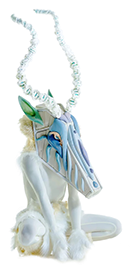
Born in 1986
Born inYokohama, Japan.
Representative of UNKNOWNWORKS.
Studied sculpture and spatial expression in Boston, USA.
Since returning to Japan, he has been involved in a wide range of creative activities, including miscellaneous goods, textiles, graphic design, interior design, and furnitures.
He uses a variety of techniques and materials in his creative activities, and incorporates the strength of nature, plants, and animals into his own mental expression.
He is self-taught in physical expression, and after a contemporary dance workshop in 2018, he began to explore the intersection of sculpture and physical expression.
Main Artistic Activities
2007 "Water Vigil" Boston Center for the Arts, Boston, MA
2008 "GLOVEBOX" Goody Glovers, Boston, MA
2007 "GLOVEBOX" Goody Glovers, Boston, MA "International Scholarship Exhibition" Art Institute of Boston, Boston, MA
2008 "Material Meditation" New Art Center, Boston, MA
2008 "Materical Meditation" New Art Center, Boston, MA "Nature & Balance" Public Art, Selected Exhibition Arcenal Center for the Arts, Watertown, MA
2009 "Facing East", Dana Art Gallery, Wellesley, MA
"Project for Destroying the Former Shiratori Residence, Yokohama, Kanagawa, Japan
2011 "DESIGN FESTA vol.1", Dana Art Gallery, Wellesley, MA
2011 "DESIGN FESTA vol.33", Tokyo Big Sight, Tokyo, Japan
2012 "GEISAI#16" Exhibition Tokyo Trade Center, Tokyo, Japan
2018 "Monster Exhibition", Shibuya Hikarie, Tokyo, Japan
2019 "Room of Wonder" Exhibition at G9G gallery, Nakameguro, Tokyo
2019 "Solid Exhibition" Exhibition at Utsuwa-ya Mahoro, Myorenji, Kanagawa, Japan
2019 "Beats Per Movement", choreographed by Mariko Kakizaki, Kagurazaka Session House, Tokyo
2020 Theater 21 Fes vol.120 "Set Up", choreographed by Kotomi Imai, Kagurazaka Session House, Tokyo
Representative Works
Re:series / 2007-2018 Not "local production for local consumption,
" but "local waste for local creation. Re:series" is a project to create works based on local garbage.
Impala / 2018-2019 A masked dance work based on the theme of "exchange of life".
This work is based on the motif of the savannah impala, which tries to live even
after dying and being eaten.
photo by Luis

JAPANESE
ENGLISH
2024©️@gallery
